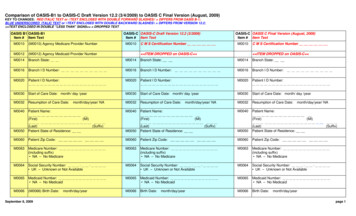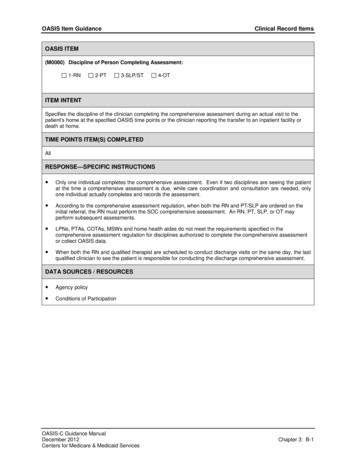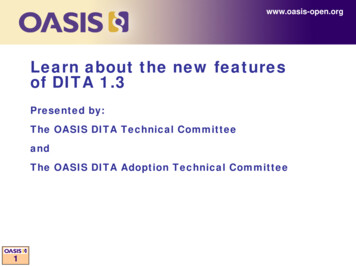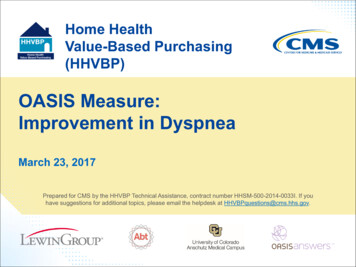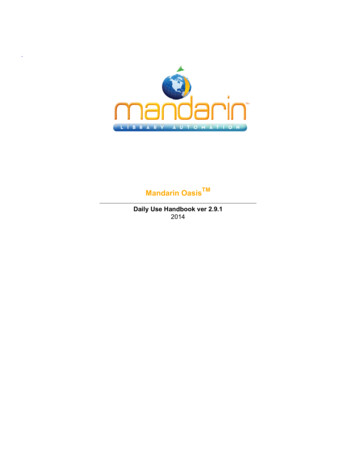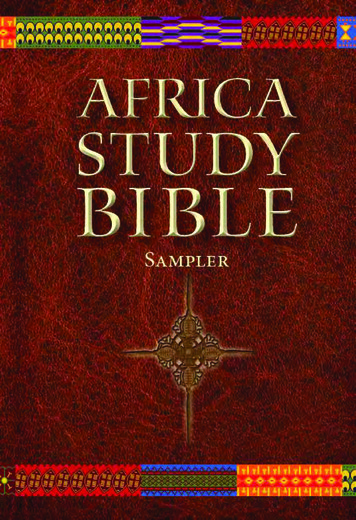
Transcription
AFRICASTUDYB I B L E SamplerUNCORRECTED PROOF
Africa Study BibleCopyright 2012, 2015, 2016 by Oasis International Limited. All rights reserved.Please visit our web page, africastudybible.com, to learn more and contribute to the Africa Study Bible project.Oasis International Limited is Satisfying Africa’s Thirst for God’s Word. Learn more at oasisint.net.ASB Cross and Africa Study Bible are trademarks of Oasis International Limited.Produced with the assistance of Livingstone, the Publishing Division of Barton-Veerman Company.Introductory artwork graciously provided by Tim Botts: timbotts.com.Colour maps copyright 2016 by Tyndale House Publishers, Inc. All rights reserved.Selections from the Ancient Christian Commentary on Scripture series are substantially edited for thiswork. Copyright 1999-2013 by the Institute of Classical Christian Studies (ICCS) and Thomas C. Oden.Used by permission of InterVarsity Press. Learn more at ivpress.com.Illustrations on pages 120-121, 436-437, 596-597, 694-695, 1514-1515, and 1542-1543 copyright 2015by Juan Velasco/5W Infographics LLC. All rights reserved.Reflections by Athanasius on each of the psalms are adapted by Larry Stone from a letter to Marcellinusby Athanasius, written in the fourth century and translated from Greek by Joel Elowsky, copyright 2016by Lawrence M. Stone and used by permission.Bible Overview Reading Plan, copyright 2016 by Sean Harrison (sah@blackearth.us). This work islicensed under a Creative Commons Attribution-ShareAlike 4.0 International License (creativecommons.org/licenses/by-sa/4.0/).Holy Bible, New Living Translation, copyright 1996, 2004, 2015 by Tyndale House Foundation. Allrights reserved.The text of the Holy Bible, New Living Translation, may be quoted in any form (written, visual, electronic,or audio) up to and inclusive of five hundred (500) verses without express written permission of thepublisher, provided that the verses quoted do not account for more than twenty-five per cent (25%) ofthe work in which they are quoted, and provided that a complete book of the Bible is not quoted.When the Holy Bible, New Living Translation, is quoted, one of the following credit lines must appear onthe copyright page or title page of the work:Scripture quotations are taken from the Holy Bible, New Living Translation, copyright 1996, 2004,2015 by Tyndale House Foundation. Used by permission of Tyndale House Publishers, Inc., CarolStream, Illinois 60188. All rights reserved.Unless otherwise indicated, all Scripture quotations are taken from the Holy Bible, New LivingTranslation, copyright 1996, 2004, 2015 by Tyndale House Foundation. Used by permission ofTyndale House Publishers, Inc., Carol Stream, Illinois 60188. All rights reserved.Scripture quotations marked NLT are taken from the Holy Bible, New Living Translation, copyright 1996, 2004, 2015 by Tyndale House Foundation. Used by permission of Tyndale House Publishers,Inc., Carol Stream, Illinois 60188. All rights reserved.When quotations from the NLT text are used in nonsalable media, such as church bulletins, orders ofservice, newsletters, transparencies, or similar media, a complete copyright notice is not required, butthe initials NLT must appear at the end of each quotation.Quotations in excess of five hundred (500) verses or twenty-five per cent (25%) of the work, or otherpermission requests, must be approved in writing by Tyndale House Publishers, Inc. Send requests bye-mail to: permission@tyndale.com or call 630-668-8300, ext. 5023.Publication of any commentary or other Bible reference work produced for commercial sale that usesthe New Living Translation requires written permission for use of the NLT text.TYNDALE, New Living Translation, NLT, the New Living Translation logo, and LeatherLike are registeredtrademarks of Tyndale House Publishers, Inc.Tyndale House Publishers ISBNs (for distribution within North America, the United Kingdom, Australia,and New Zealand only):ISBN 978-1-4964-2471-6 HardcoverISBN 978-1-4964-2472-3 LeatherLike Brown16 17 18 19 20 BPI 10 9 8 7 6 5 4 3 2 1
TA B L E O F C O N T E N T SIntroduction to the Africa Study Bible .5Articles and Learn Notes Index .13Partners, Contributors, and Editors .16You Can Trust the Notes in this Bible . 25Using the Africa Study Bible .27History and Vision of the Africa Study Bible. 30Introduction to the New Living Translation. 33A Note of Thanks . 43The Story of the Bible . 44Understanding and Applying the Old Testament Today.47Hosea.51Marriage . 68James .73Children at Risk . 84Leadership in Africa . 87A History of Christianity in Africa . 90A Narrative Timeline of God’s Work in Africa .93
Introduction totheAFRICASTUDYB I B L E 5
GOD’S WORD THROUGH AFRICAN EYESThe Africa Study Bible is a pacesetter in using the African experience for understanding the Bible.I recommend it highly to those who have sought to understand life and the world from an Africanperspective.Dr. Mvume Dandala, former presiding bishop of the Methodist Church ofSouthern Africa and former head of the All Africa Conference of ChurchesThe Africa Study Bible is a welcome blessing to the body of Christ in Africa, which is becoming acenter piece for divine visitation. The most difficult concepts, names, periods, and situations thatAfrican readers grapple with, have been greatly simplified by making them relevant to our understanding and context. These were further made easier by including various explanatory notes,relevant articles, African proverbs, idioms, and pithy sayings. All of these make both the readingand study of the Bible much easier and friendly to Africans.This study Bible demonstrates two important things about our church in Africa. First, we arecoming of age. We no longer have to get most of our Bible study resources from outside Africa. TheSpirit of Jesus anointed well over 300 African writers, who contributed to this highly useful studyBible, the first of its kind on the African continent. Second, we are coming together. We Christianshave far more that unites us than divides us. Therefore, the traditional missionary churches, thePentecostals, the indigenous African churches, and others laid aside our minor differences to writethe notes for this study Bible that can teach and bless all of us. This is the Holy Spirit in action. Jesus’prayer on his last night on this earth—that “we may be one” is being answered in this study Bible. Ioffer my most sincere congratulations and thanks to all our brothers and sisters who have contributed to this study Bible through coordinating, writing, editing, and funding. I, therefore, endorseand recommend it very highly to all Christians, churches, and students of the Bible.Pastor E. A. Adeboye, General Overseer, Redeemed Christian Church of GodThe Africa Study Bible is a clear indication that the African Church has come of age. In this publication, different African Christian Leaders interact with scripture using African lenses yet remainfaithful to the evangelical doctrine. I commend it to all readers, African or otherwise.Rev. Canon Peter Karanja, General Secretary, National Council of Churches of KenyaHere is a fresh study Bible of significant value written by African scholars from an African perspective. This is indeed a much-awaited contribution to our appreciation and deeper understanding ofthe biblical narratives in a context, which is very much closer to the African culture and worldview.It is hoped that not only Africans but also people from other cultures would find this study mostbeneficial for personal devotion and spiritual development.Dr. Opoku Onyinah, Chairman, The Church of PentecostThe emergence of the Africa Study Bible is, no doubt, divinely providential as the church in Africa.is clearly fast becoming the global missionary hub of the twenty-first century and the center ofworld Christianity. Oasis International is being used by God to bring us this gift that is an amazingtool to grow the church in Africa in understanding doctrine, values, and the Bible. It is contextual,culturally relevant, and truly indigenous as God’s Word through African eyes. The ASB is highlyrecommended for every professing Christian in Africa.Dr. Dachollom C. Datiri, President, Church of Christ in NationsI welcome this collaboration and fruits of the Africa Study Bible and commend it to readers throughoutthe world. Of course the Bible is universal, but it is always given life by the lived experiences of thepeople of God.Dr. Thabo Makgoba, Archbishop, Church of South Africa, Anglican Community6
YOU CAN TRUST THE NOTES IN THIS BIBLEYou can trust the text (see “Introduction to theNew Living Translation”) and notes of theAfrica Study Bible (ASB). The ASB has undergoneone of the most thorough and rigorous qualityreviews of any study Bible or Bible reference bookin the world. The message, theology, and formathave been checked and double checked to assurethat the ASB speaks with a unified voice; adheresto the highest editorial standard; and is clear,readable, and biblically accurate.The editorial leaders, following the mandateof the Founding Committee of the Africa StudyBible, were deeply aware that there is a blessedand full diversity within the body of Christ. Infact, the editorial team itself was carefully chosento accurately reflect the diversity of the church inAfrica. Great effort was made to assure that correct and accepted Christian beliefs are reflectedand encouraged, while allowing for differencesin opinion on non-essential issues.It is best to let the editorial process speak foritself:1. Denominational or ministry leaders whoare scholars, pastors, or elders recommendedpotential writers. Writers were given assignments based on specifications establishedby the Founding Committee of the AfricaStudy Bible, including language, gender, andgeographic diversity. Writing coordinatorsworked to match each contributor’s expertisewith a topic or passage to encourage qualitysubmissions.The contributors represented people whoseheart languages range from Yoruba in westernAfrica to Swahili in the east, and from Zulu inthe south to Amharic in the north. Besides English, many wrote in French and some in Portuguese, Arabic, or Swahili. A team translatedtheir contributions into the English that youwill read here.25We are thrilled that the ASB met these goalsfor country, language and gender diversity: writers from fifty countries one hundred ninety-four writers fromAnglophone countries one hundred writers from Francophonecountries eleven from Portuguese-speaking countries eleven from Arabic-speaking countries sixty-nine female writers2. Supervising editor Dr. John Jusu reviewed,commented on, and approved every submission—often sending material back to a writerfor revision when needed.3. A team of editors worked to standardizesubmissions so the Africa Study Bible speaks witha unified voice.4. Edited articles and notes by book batcheswere sent to a group of ten African theologicalscholars to review and make suggestions for improvement.5. An experienced Bible editorial team revised the material according to the African scholars’ suggestions and edited the articles and notesfor clarity.6. Two senior Ph.D.-level theological editorsreviewed the revised articles and notes book bybook.7. Finally, the articles and notes were copyedited and checked for reading level and accessibility by the target audience.8. Once typeset into the current format, theentire biblical text, articles, notes, and supplemental study materials were proofread to assureaccuracy and editorial excellence.Fourteen to twenty individuals reviewed, edited, and proofread each note and article. Thisrigorous and exhaustive process assures us thatthe Africa Study Bible speaks with the highestquality as a trusted resource for the church.
SYMBOLS OF THE AFRICA STUDY BIBLEThis Ornate Cross serves as the primary symbol of the AfricaStudy Bible. The four points of the cross represent the four cornersof Africa: North, South, East, and West. The points are comprisedof spears, as the holy Word of God serves as our primary weaponin the battle for his kingdom. The concentric rings representthe unity the Gospel can bring to people of every country, race,and denomination. Finally, the four shields represent God’s allencompassing protection of those he has called to faith, suchthat they need fear only him.The Coptic Cross highlights “Learn” features in the Africa StudyBible, which provide key historical doctrinal understandingsof God’s Word and the Church. It represents the North Africanregion, reminding readers of Africa as ancient seat of Christianity,home of Augustine and Athanasius.The “Mate Masie” highlights the “Proverbs and Stories” features,revealing the connection between uniquely African sayings andthe wisdom of Scripture. It is an Adinkra symbol, representingWest Africa, and stands for wisdom and for God’s omniscience.The Nguni symbol for “Made Peace” serves to highlight the“African Touch Points” features, where Scripture and the Africanway of life are considered and reconciled. Representing SouthernAfrica, this symbol serves to represent our peace with God andone another.The Masai Shield and Spear highlight “Application Notes,” whichequip the reader with the tools they need to act righteously andfight for God’s glory. Representing East Africa, these symbolsremind readers of the safeguard of faith and of the great powerof God’s Word to defeat Satan.26
USING THE AFRICA STUDY BIBLEEAs Paul reminds us in 2 Timothy 2:15: “Workhard so you can present yourself to God and receive his approval. Be a good worker, one whodoes not need to be ashamed and who correctly explains the word of truth.”ach feature of the Africa Study Bible wasplanned by African leaders who teach andlead God’s people. Their goal was to help us growstrong in Jesus Christ and to give insight aboutGod’s Word to the continent and to the world asGod’s Word Through African Eyes.Each note is written to inform us about animportant topic or to help us understand a verseor passage. This is not information to memorizebut instruction on how to live a good and righteous life. Each is based on God’s wisdom andtruth. What are the special concerns and issuesthat we face in Africa? How does God want us tolive as we face each challenge? Even as we askthose questions, the Africa Study Bible is muchmore. It will teach us how to apply the Word ofGod to our lives. Each day, we must open theBible and let it be God’s bread for us through thepower of the Holy Spirit.The notes in the Africa Study Bible can showus, by example, how to apply God’s truth. Sometimes our thinking or our culture really fits thetruth in God’s Word, and this Bible shows ushow to celebrate and encourage that. Sometimes we need correction from God’s Word, andwe need to learn to think and live differently.Perhaps we need to find a new path or even repentance. The Africa Study Bible shows us howto do that, too. And sometimes, the Africa StudyBible will help us grow deep and mature in ourfaith or encourage us in the tough times.It is our prayer that we will not only be readingand learning what others have to say about theBible, but we will be learning by example to takewhat we are reading and apply it in a way thathonours God and builds his Kingdom for ourselves. The Africa Study Bible is written by leaders across our continent who have worked theirentire lives to learn how to apply the truth foundin the Bible. They wish to be faithful in applyingGod's Word to our lives in Africa and the world.As we read and listen to their wisdom, we canlearn this skill as well. The Bible has many moreapplications than we will find in this Bible, butby observing how to apply the Bible correctly, wecan learn to apply the Bible to our own situation.If you would like to learn more, we have developed tools that teach how to apply the Bible. Visitafricastudybible.com for more information.African Touch Points draw attention to Scripture passages with a special connection to Africa. There are three kinds of Touch Points. Insome Touch Points, we explore a passage wherethe Bible talks about Africa or a person fromAfrica. Other Touch Points have an importantquotation from one of the greatest early AfricanChristian leaders, whose writings and teachingshelped shape all of Christianity. Listen carefully to the voices of thinkers such as Augustine,Athanasius, Cyril, and Origen. Finally, manyof the Touch Points feature an example of howAfrican culture sheds light on the meaning of apassage. Often, African cultures are much closer to the culture of the Bible than the culturesof North America and Europe. This is a keyarea where the African church can speak aboutthe significance and impact of Scripture to theworldwide church.Introductions to each book of the Biblehelp us understand its history and biblicalcultures. They have a special focus on issuesclose to the African heart. Sometimes a bookof the Bible does not tell us who wrote it, butmost often we have evidence that may point toa particular person. Sometimes scholars whostudy the Bible disagree about who wrote abook of the Bible. Some stories were passed onorally for a long time before they were writtendown, just as is common in our culture. A priestor a prophet may have written stories down oredited a book years after it was first written tohelp it speak correctly to his own time. But wehave historical evidence showing us that therewas a very accurate transmission of the storieswritten in the Bible. We can trust that Godinspired this process, and Jesus affirms the OldTestament as the Word of God. In the AfricaStudy Bible, when we do not know who was theoriginal author, we may say something like “According to Jewish tradition, Moses wrote Genesis.” We affirm with our whole hearts the wordsof 2 Timothy 3:16: “All Scripture is inspired by27
28God and is useful to teach us what is true andto make us realize what is wrong in our lives. Itcorrects us when we are wrong and teaches usto do what is right.”Beyond listing general facts, the introductionswill connect you to the original purpose and audience. Many books of the Bible were originallyread aloud to a group of people or even sung.They are written records of stories, poems, andinstructions that people often heard rather thanread. Like musicians, often the authors used repeating patterns to communicate their message.They also focused on characters and plot to makea point, like great storytellers. They had a messagefor the listener to learn. The book introductionhighlights the story and the rhythm of each Biblebook and what the book can teach us, just like thetraditional African storyteller.Application Notes are used to inspire readersto apply what the Bible teaches to our lives.They will help us reflect on issues in light ofthe truths in Scripture. These notes can showus how the Bible's message should changethe way we live. They also help us understandhow to apply truth from Scripture to our dailylives. The goal of our writers is to teach us tothink about all issues in light of what the Bible says. We can use these notes to learn howto apply the Bible to our lives. First we workto understand the meaning of the text in theBible, then we apply that truth to our currentsituation.Proverbs and Stories illuminate andcomplement the biblical text. The Africanpeoples have a wealth of wise sayings, fables,and stories that the Africa Study Bible explores.These have been referred to as the treasures ofAfrica or the wisdom of the elders. This featurewill help the Bible come alive by highlightingpassages that have parallels with a specific African proverb or story. The proverb or story isused as a starting place to illuminate the original meaning of the Bible. Proverbs may eitherbe in agreement or in conflict with the text. Wecan follow this example to learn how the Biblerelates to our cultures either positively or negatively. In all things, the truth of the Bible is to beour authority even when it does not agree withtraditional wisdom. Often specific regions ortribes are identified, with the proverb quotedin the original language. These sayings are thework of the original author and no attempt hasbeen made to check for accuracy.Articles are about living the Christian lifeand critical concerns that face the Africanchurch and its people. The committee chosearticle topics and gave writers main pointsand issues to address. Each Article was writtenwith the following three questions: (1) Whatis the biblical basis for the perspective beingpresented? (2) What are the specific Africanissues for this topic? (3) How may the truth beapplied to everyday life? The Articles appearbetween books of the Bible so they do not interrupt the flow of the text. Read through theindex to find a topic of interest to you. Articleswill help us understand how to apply the Bibleto a specific area of life where God’s wisdomis needed.Learn Notes expand our thinking in theology,doctrine, and biblical values. The committeechose important topics to be explored, thingsthat “every Christian should know.” Each LearnNote explains the topic, giving a basic understanding that the majority of Christians agreeon. At least one special point of interest or application for Africa is considered for every topic.Learn Notes are placed near scripture aboutthe topic. Learn Notes show us how to discernthe great doctrines of our faith by listening tothe whole Bible speak with a unified voice.Learning and Teaching Helps are includedthroughout and at the back of the Bible. TheTopical Index and Concordance lists all theArticles, Application Notes, Stories and Proverbs,African Touch Points, and Bible references thatgive insight into a particular topic. This Topical Index and Concordance also includes twoother special features. Words that have specialmeaning for the church are explained—likepropitiation or sanctification. Also, this feature defines English words from the text of theBible that may be unclear or are seldom used inAfrica. A brief biography of each Early AfricanChurch Father who is quoted in African TouchPoints is included. This one feature, will equipus to learn or teach about almost any topicfound in the Bible.You will also find a special feature presenting the history of God’s people in Africa—ANarrative Timeline of God’s Work in Africa.This unique graphical timeline will help youunderstand God’s work in Africa from Abraham through the year 2010—it is an insightfuloverview of all God has done in our continentover almost 4,000 years.
29In addition, maps and other graphicaltimelines and features are spread throughoutthe Bible to help us understand the locations,people, time, and structure of the Bible. One ofthe features, Harmony of the Gospels, located at the end of the Gospel of John, gives usa wonderful overview of how the four Gospelstell a unified story and also how they tell theLife of Jesus from different viewpoints.Bible Overview Reading Plan was createdspecifically for the Africa Study Bible. Here is aplan to give you an overview of the whole Biblein one year by reading the length of a chaptersix days a week. If you committ to this, you willreceive a wonderful understanding of the storyof God reaching out to us.All of these features help us understand thewonder and diversity of the Bible, the richChristian heritage of Africa, and the part thatAfrica played in the events of the Bible.Colorful original art in the front of the AfricaStudy Bible was created to show the beauty andpower of God’s Word. Verses were chosen thathighlight the project’s goals and beloved verses give encouragement and power as they arememorized, shared, and hidden in our hearts.The art is built from many of the scripts, symbols, colors, and patterns of Africa. Here is abrief explanation of each piece:Mark 12:29-31—The two greatest commandments are illustrated. The spiraling circleat the top represents the eternal God and therow of people at the bottom represents ourneighbors. The two tablets, also in the background, remind us of the Ten Commandmentswhich can be summarized in these two commands given to us by Jesus.Ephesians 2:8-10—A special robe celebratesthe great honour God has given us to be a partof his family when we trust Christ. The letteringfor "God's Masterpiece" is designed to expressthe uniqueness of each one of us working together to bless the world.Galatians 5:22-23—In these verses, we canimagine various fruits on the same tree. Thisillustrates the supernatural nature of thesecharacter traits. The roots of the tree are included at the bottom to remind us that God'sSpirit makes us strong and enables us to liveabundantly.Psalm 67—A compass pattern was chosento represent God's rule and guidance over allthe world's peoples. The words follow the arc ofthe globe, stretching from one end of the earthto the other. The gold dots radiate from God'sname to illustrate that he is the source of allblessing.Psalm 91—The large background symbolrepresents the confidence that we should fearno one except God. The psalmist expresses thattrust in the Most High through the gentle metaphor of a bird's wings. This reminds us thatGod's Spirit also revealed himself in the formof a dove when Jesus was baptized.1 Corinthians 11:23-26—Jesus uses two pictures of the great sacrifice he made for us to beforgiven and accepted by a holy God. The first,his body broken for us, is illustrated here in across made from staffs of grain which sproutnew life. The second diagonal image is ofChrist's blood poured out freely as representedin the wine shared with his disciples.Philippians 4:12-13—A symbol for strengthand humility is shown very large in the background to illustrate the power of Christ to helpus do what we can't accomplish in our ownstrength. The cross, centrally located in the design, reminds us of the great cost by which wehave access to His strength.Romans 8:38—In lettering art, the artistattempts to make words look like what theymean. So these words are designed to showgreat confidence strong and close together. Incontrast, "God's Love" is written in a gentle,comforting style. The background shield represents the assurance that this eternal love protects us.2 Timothy 4:2—God's Word, the Holy Bible,represented here by a sword and fiery flames,has the power to change us as we listen andobey. The different styles of lettering help to express the meaning of each word or phrase.
HISTORY AND VISION OFTHE AFRICA STUDY BIBLEHistoryThe concept of a study Bible specifically createdfor the needs of African Christians was birthed intalks among African leaders, Oasis International, and Tyndale House Publishers. A survey andstatistical analysis to evaluate the understanding of the Bible by Christians in Jos, Nigeria, wasundertaken to evaluate the potential impact ofhaving the Bible in clear, modern language using African vocabulary and expressions. Theresearch clearly showed that meanings of wordsand expressions in modern English from theUnited States or the United Kingdom were notalways clear for English-speaking Africans.Over the following years, the project movedforward through conversations with leadersthroughout Africa, Bible experts at Tyndale, andthe Oasis International Board. These conversations included Dr. Tite Tiénou from Burkina Faso,a member of the team that formed the vision forthe Africa Bible Commentary. He would soon bejoined by several other contributors to the AfricaBible Commentary.It was decided that the project, if attempted,would focus on discipleship and life transformation by providing tools and helps to growChristians deep in their faith.During an extensive period of evaluatingthe need for the project, leaders from the continent were asked to give input. Seminary presidents, denominational leaders, and academicsspoke with unity: It was essential that we createa study Bible to reflect the knowledge, culture,and wisdom of Africa, with the purpose of growing African Christians and bringing insight toglobal Christianity.Brought together by Oasis International, theproject soon had a number of strong development partners, each bringing their unique skillsto the project. Special honour is due TyndaleHouse Publishers and Tyndale House Foundation, who provided expertise and seed funding.In addition, Livingstone, the creators of the bestselling Life Application Study Bible, began theirrole as consultant and editorial manager. Afterextensive preparation, the Founding Committeeof the Africa Study Bible met in Accra, Ghana.Leaders from every region of Africa, representingEnglish, French, Portuguese, and Arabic speaking areas and eleven countries formed the finalmandate for the project, making all major editorial decisions. Special thanks goes to MarkTaylor, Bruce Barton, Jeff Wright, and MatthewElliott—publishing experts who joined the meetings in Accra to advise the committee in studyBible creation.The committee came together in a spirit ofunity; the cornerstone of the meetings was a belief in the power and authority of God’s Wordand
is study Bible demonstrates two important things about our church in Africa. First, we are coming of age. We no longer have to get most of our Bible study resources from outside Africa. e Spirit of Jesus anointed well over 300 African writers, who contributed to this highly useful study Bible
